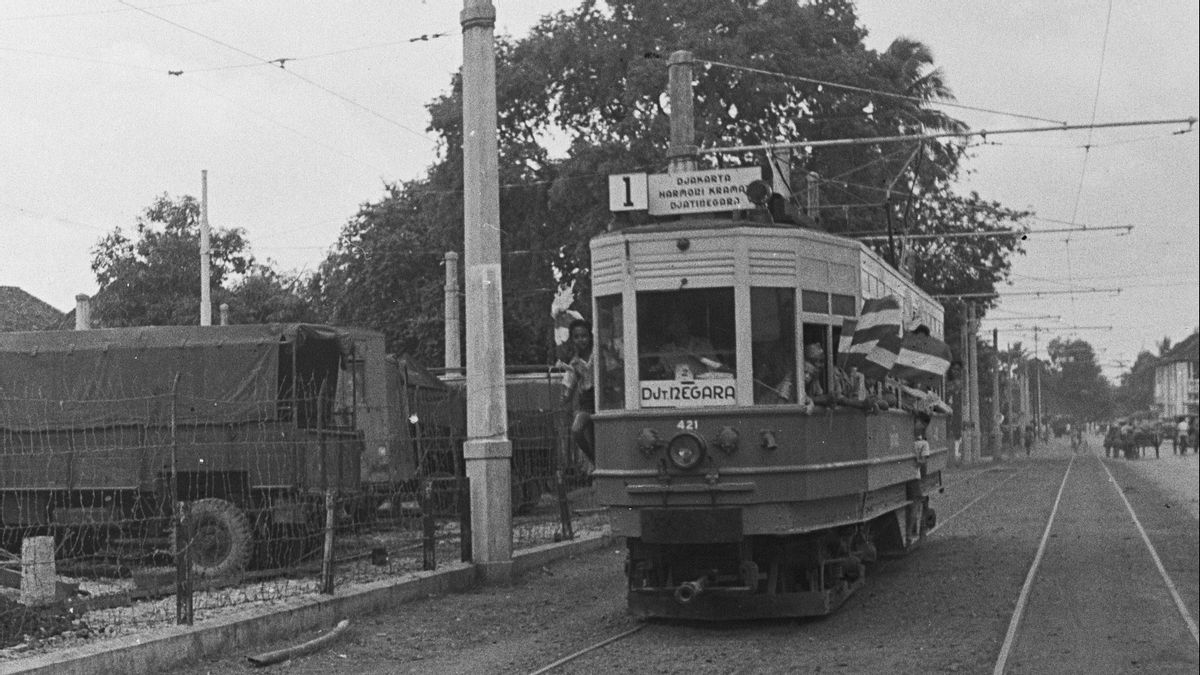JAKARTA - Mass transportation technology in Batavia or Jakarta has developed rapidly since the end of the 19th century. After horse-powered trams appeared in 1869, they evolved into steam-powered trams in 1882, until they successfully adopted the electric tram in April 1899.
Electric trams even existed in Batavia before in the Netherlands. It is recorded that the country of windmills only adopted this mode of public transportation in July 1899, or more precisely three months after Batavia. This then became the talk of the whole city.
The making was unmitigated. In addition to the lijn (track) that was built in almost all important areas of Batavia, the operation schedule was busy, which was once every 10 minutes.
Just like steam trams, passenger classes on electric trams are also differentiated. The first class with a ticket price of 15 cents is usually boarded by Europeans. Then, second class with a ticket price of 10 cents, usually contains passengers from foreign easterners, such as Chinese, Arabs and Indians. Finally, the third class is reserved for native people at a rate of 5 cents. One way, the tram is capable of pulling three carriages.

Due to this development, a special commission from Indisch Genootschap praised the presence of this iron rail-based public transportation as a form of human victory over distance and time. Moreover, all the materials from the electric tram are produced directly by the Belgian factory, Dyle en Becalan.
"The most useful of the findings today, the most amazing victory by humans over time and distance, the most powerful incentive to work hard, exchange of values, and civilization," said Indsich Genootschap quoted by Rudolf Mrazek in Engineers of Happy Land: Development Technology and Nationalism in a Colony (2006).
As quoted by Mona Lohanda in her book History of the Authorities Who Manage Batavia (2007), at first, electric trams were managed by the Batavia Elektrische Tram Maastschappij (BETM) company. Then when Burgermeester (Mayor) Batavia, Ir. Voorneman realized the great potential of this company in 1925, he merged the company with the Nederlandsch-Indische Tramweg Maatchappij (NITM), until the Bataviasch Verkeers Maatschappij (BVM) was born.
The combination of the two companies inherited the management of electrification on electric trams which was completely completed on March 1, 1934. Meanwhile, steam tram operation had stopped a year earlier in September 1933 because it was no longer relevant to the times. In more detail, we have reviewed it in the article "There is no transportation more deadly than the steam tram in Batavia."
This trolleybus route extends to six lines. First, the Fish Market-Kampung Melayu. Second, Fish Market-Gondangdia. Third, Fish Market-Gondangdia via Sawah Besar. Fourth, Fish Market - Tanah Abang. Fifth, Tanah Abang-Jakarta City. Sixth, Jakarta Kota-Jembatan Lima.
Thanks to the famous electric tram, the Dutch writer, Louis Couperus in his novel entitled De Stille Kracht (1900) to cover the case of the existence of electric trams in Batavia. Couperus called Europeans using electric trams at that time as a form of their misery in the Dutch colony.
“In the morning, while she is shopping at the shops in Rijswijk and Molenvliet, which, some have French names, try to give the southern shopping center a European luxury, Eva sees an exodus to the Old Town of white people. The exodus filled the tram with the white weight of death. Many, who were already rich, but not rich enough for their purposes, took the tram with their trains to the Club of Harmony, where they took the tram to save their horses, ”said Couperus.

The existence of the electric tram has a long life. After Indonesia's independence from Dutch colonialism, the electric tram network was still operating on several main streets of Jakarta. The enthusiasm of the Indonesian people at that time was quite high for public transport vehicles from the Dutch colonial heritage in the early 1950s.
Unfortunately, in around 1959 the electric tram was discontinued. Investigate it, the termination is due to the problem of lack of funds to treat and rejuvenate it. Therefore the policy owners decided to stop the electric tram operation. To the extent that, the tracks were barely left over.
"The former track is now covered with road asphalt, there is no trace anymore. During the excavation at the roadside in the Kota area for the renovation project of the Old City by the DKI Jakarta Government in 2006, several former electric tram tracks were found. The poles that support the electric cables are no longer there. It's a shame that this electric tram was removed, ”wrote Firman Lubis in the book Jakarta 1950-1970 (2018).
Unfortunately it was stoppedFirman Lubis criticized the stopping of the electric tram operation. He said the owners of policies were incapable of maintaining and improving important public transportation facilities such as electric trams.
This is exacerbated by the absence of experts in the field of urban planning, particularly in the field of public transportation. In fact, the presence of electric trams is very practical and free from pollution.
Not only Firman, Heri Sugiarto in the book Overland: From Lionland to Mainland China Volume 2 (2018), had mentioned a little about the triumph of the tram which eventually went out of business. Heri said that the operation of electric trams was suspended because the old order government felt that the trams were not suitable for Jakarta's future development plans.
"However, unfortunately the triumph of the electric tram did not last long and had to end in the 1960s during the Old Order. For trams in Jakarta, reportedly there are various reasons why this tram has been suspended, one of which is President Soekarno's thought that trams were not suitable for being in Jakarta and wanted a subway to exist, "concluded Heri Sugiarto.
The English, Chinese, Japanese, Arabic, and French versions are automatically generated by the AI. So there may still be inaccuracies in translating, please always see Indonesian as our main language. (system supported by DigitalSiber.id)












